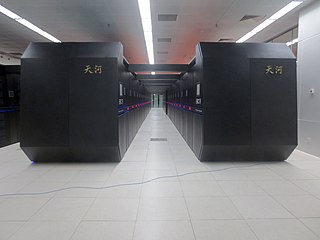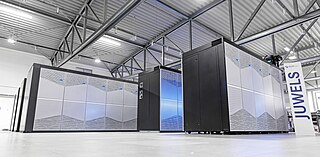Top 10 ranking
According to June 2024 release of the list, for the BFS results section, Fugaku ranks highest, but in the SSSP results section Wuhan Supercomputer ranks highest, then Pengcheng Cloudbrain-II, then Fugaku; table shows for BFS results: [7]
| Rank | Country | Site | Machine (architecture) | Number of nodes | Number of cores | Problem scale | GTEPS |
|---|---|---|---|---|---|---|---|
| 1 | RIKEN Advanced Institute for Computational Science | Supercomputer Fugaku (Fujitsu A64FX) | 152064 | 7299072 | 42 | 166029 | |
| 2 | Wuhan | Kunpeng 920+Tesla A100 | 252 | 6999552 | 41 | 115357.6 | |
| 3 | Frontier | HPE Cray EX235a | 9248 | 8730112 | 40 | 29654.6 | |
| 4 | Pengcheng Lab | Pengcheng Cloudbrain-II (Kunpeng 920+Ascend 910) | 488 | 93696 | 40 | 25242.9 | |
| 5 | DOE/SC/Argonne National Laboratory | HPE Cray EX - Intel Exascale Compute Blade | 4096 | 25591808 | 40 | 24250.2 | |
| 6 | National Supercomputing Center in Wuxi | Sunway TaihuLight (Sunway MPP) | 40768 | 10599680 | 40 | 23755.7 |
Spain (Barcelona), has a new supercomputer MareNostrum 5 ACC, ranked 8th.
2022
According to November 2022 release of the list: [8]
| Rank | Country | Site | Machine (architecture) | Number of nodes | Number of cores | Problem scale | GTEPS |
|---|---|---|---|---|---|---|---|
| 1 | RIKEN Advanced Institute for Computational Science | Supercomputer Fugaku (Fujitsu A64FX) | 158976 | 7630848 | 41 | 102955 | |
| 2 | Pengcheng Lab | Pengcheng Cloudbrain-II (Kunpeng 920+Ascend 910) | 488 | 93696 | 40 | 25242.9 | |
| 3 | National Supercomputing Center in Wuxi | Sunway TaihuLight (Sunway MPP) | 40768 | 10599680 | 40 | 23755.7 | |
| 4 | Information Technology Center, University of Tokyo | Wisteria/BDEC-01 (PRIMEHPC FX1000) | 7680 | 368640 | 37 | 16118 | |
| 5 | Japan Aerospace Exploration Agency | TOKI-SORA (PRIMEHPC FX1000) | 5760 | 276480 | 36 | 10813 | |
| 6 | EuroHPC/CSC | LUMI-C (HPE Cray EX) | 1492 | 190976 | 38 | 8467.71 | |
| 7 | Oak Ridge National Laboratory | OLCF Summit (IBM POWER9) | 2048 | 86016 | 40 | 7665.7 | |
| 8 | Leibniz Rechenzentrum | SuperMUC-NG (ThinkSystem SD530 Xeon Platinum 8174 24C 3.1GHz Intel Omni-Path) | 4096 | 196608 | 39 | 6279.47 | |
| 9 | Zuse Institute Berlin | Lise (Intel Omni-Path) | 1270 | 121920 | 38 | 5423.94 | |
| 10 | National Engineering Research Center for Big Data Technology and System | DepGraph Supernode (DepGraph (+GPU Tesla A100)) | 1 | 128 | 33 | 4623.379 |
2020
2016
According to June 2016 release of the list: [10]
| Rank | Site | Machine (architecture) | Number of nodes | Number of cores | Problem scale | GTEPS |
|---|---|---|---|---|---|---|
| 1 | Riken Advanced Institute for Computational Science | K computer (Fujitsu custom) | 82944 | 663552 | 40 | 38621.4 |
| 2 | National Supercomputing Center in Wuxi | Sunway TaihuLight (NRCPC - Sunway MPP) | 40768 | 10599680 | 40 | 23755.7 |
| 3 | Lawrence Livermore National Laboratory | IBM Sequoia (Blue Gene/Q) | 98304 | 1572864 | 41 | 23751 |
| 4 | Argonne National Laboratory | IBM Mira (Blue Gene/Q) | 49152 | 786432 | 40 | 14982 |
| 5 | Forschungszentrum Jülich | JUQUEEN (Blue Gene/Q) | 16384 | 262144 | 38 | 5848 |
| 6 | CINECA | Fermi (Blue Gene/Q) | 8192 | 131072 | 37 | 2567 |
| 7 | Changsha, China | Tianhe-2 (NUDT custom) | 8192 | 196608 | 36 | 2061.48 |
| 8 | CNRS/IDRIS-GENCI | Turing (Blue Gene/Q) | 4096 | 65536 | 36 | 1427 |
| 8 | Science and Technology Facilities Council – Daresbury Laboratory | Blue Joule (Blue Gene/Q) | 4096 | 65536 | 36 | 1427 |
| 8 | University of Edinburgh | DIRAC (Blue Gene/Q) | 4096 | 65536 | 36 | 1427 |
| 8 | EDF R&D | Zumbrota (Blue Gene/Q) | 4096 | 65536 | 36 | 1427 |
| 8 | Victorian Life Sciences Computation Initiative | Avoca (Blue Gene/Q) | 4096 | 65536 | 36 | 1427 |
2014
According to June 2014 release of the list: [2]
| Rank | Site | Machine (architecture) | Number of nodes | Number of cores | Problem scale | GTEPS |
|---|---|---|---|---|---|---|
| 1 | RIKEN Advanced Institute for Computational Science | K computer (Fujitsu custom) | 65536 | 524288 | 40 | 17977.1 |
| 2 | Lawrence Livermore National Laboratory | IBM Sequoia (Blue Gene/Q) | 65536 | 1048576 | 40 | 16599 |
| 3 | Argonne National Laboratory | IBM Mira (Blue Gene/Q) | 49152 | 786432 | 40 | 14328 |
| 4 | Forschungszentrum Jülich | JUQUEEN (Blue Gene/Q) | 16384 | 262144 | 38 | 5848 |
| 5 | CINECA | Fermi (Blue Gene/Q) | 8192 | 131072 | 37 | 2567 |
| 6 | Changsha, China | Tianhe-2 (NUDT custom) | 8192 | 196608 | 36 | 2061.48 |
| 7 | CNRS/IDRIS-GENCI | Turing (Blue Gene/Q) | 4096 | 65536 | 36 | 1427 |
| 7 | Science and Technology Facilities Council - Daresbury Laboratory | Blue Joule (Blue Gene/Q) | 4096 | 65536 | 36 | 1427 |
| 7 | University of Edinburgh | DIRAC (Blue Gene/Q) | 4096 | 65536 | 36 | 1427 |
| 7 | EDF R&D | Zumbrota (Blue Gene/Q) | 4096 | 65536 | 36 | 1427 |
| 7 | Victorian Life Sciences Computation Initiative | Avoca (Blue Gene/Q) | 4096 | 65536 | 36 | 1427 |
2013
According to June 2013 release of the list: [11]
| Rank | Site | Machine (architecture) | Number of nodes | Number of cores | Problem scale | GTEPS |
|---|---|---|---|---|---|---|
| 1 | Lawrence Livermore National Laboratory | IBM Sequoia (Blue Gene/Q) | 65536 | 1048576 | 40 | 15363 |
| 2 | Argonne National Laboratory | IBM Mira (Blue Gene/Q) | 49152 | 786432 | 40 | 14328 |
| 3 | Forschungszentrum Jülich | JUQUEEN (Blue Gene/Q) | 16384 | 262144 | 38 | 5848 |
| 4 | RIKEN Advanced Institute for Computational Science | K computer (Fujitsu custom) | 65536 | 524288 | 40 | 5524.12 |
| 5 | CINECA | Fermi (Blue Gene/Q) | 8192 | 131072 | 37 | 2567 |
| 6 | Changsha, China | Tianhe-2 (NUDT custom) | 8192 | 196608 | 36 | 2061.48 |
| 7 | CNRS/IDRIS-GENCI | Turing (Blue Gene/Q) | 4096 | 65536 | 36 | 1427 |
| 7 | Science and Technology Facilities Council - Daresbury Laboratory | Blue Joule (Blue Gene/Q) | 4096 | 65536 | 36 | 1427 |
| 7 | University of Edinburgh | DIRAC (Blue Gene/Q) | 4096 | 65536 | 36 | 1427 |
| 7 | EDF R&D | Zumbrota (Blue Gene/Q) | 4096 | 65536 | 36 | 1427 |
| 7 | Victorian Life Sciences Computation Initiative | Avoca (Blue Gene/Q) | 4096 | 65536 | 36 | 1427 |









